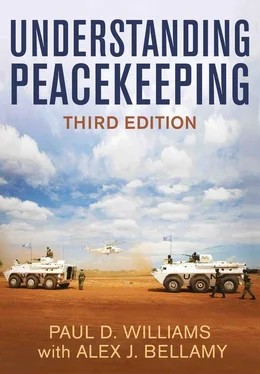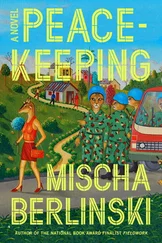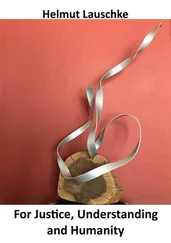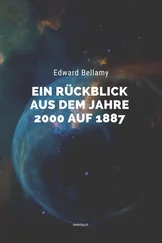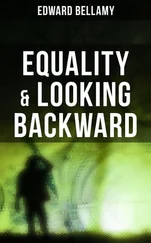1 ...8 9 10 12 13 14 ...31
Box 1.1 Advocates of liberal peace
There is an obvious connection between democratic practices – such as the rule of law and transparency in decision-making – and the achievement of true peace and security in any new and stable political order. These elements of good governance need to be promoted at all levels of international and national political communities. (Boutros-Ghali 1992: §59)
Democracies don’t attack each other … ultimately the best strategy to insure our security and to build a durable peace is to support the advance of democracy elsewhere. (US President Bill Clinton, ‘State of the Union Address’, New York Times , 26 January 1994)
The right to choose how they are ruled, and who rules them, must be the birthright of all people, and its universal achievement must be a central objective of an Organization [the UN] devoted to the cause of larger freedom … The United Nations does more than any other single organization to promote and strengthen democratic institutions and practices around the world. (Annan 2005a: §§148 and 151)
I believe that as imperfect as they are, the principles of open markets and accountable governance, of democracy and human rights and international law that we have forged remain the firmest foundation for human progress in this century. (US President Barack Obama, speech to the United Nations General Assembly, 20 September 2016)
Although liberal peace has been the dominant theory underpinning many contemporary peace operations, its application remains controversial for several reasons. First, many powerful actors around the world, including rising powers such as China, retain distinctly illiberal political preferences. Second, liberal reforms have often been rejected by powerful local constituencies on the receiving end of such peace operations. And, third, partly because many of the world’s peacekeepers come from countries without a domestic tradition of liberalism. The assumptions behind the liberal peace have also been challenged by scholars. Some deny the basic empirical assertion at the heart of liberal peace theory by pointing to wars between or within democracies or arguing that the dataset remains too small to draw statistically relevant conclusions (e.g. Mearsheimer 1994). Others warn that, while the goal is laudable, the rapid liberalization of post-war societies has destabilizing effects that undermine the chances of achieving stable peace (e.g. Paris 2004). Still others suggest the values underpinning liberal peace are not universal or causally connected to peace but reflect the ideological preferences of the world’s most powerful actors (e.g. Barkawi and Laffey 1999). Because of this, some realists argue that powerful states should not allow themselves to become entangled in the domestic affairs of others, except on the rare occasions where vital national interests are at stake (e.g. Mearsheimer 2018; Walt 2019). In response, defenders of liberal peacebuilding have criticized the critiques as faulty and made the prudential case that ‘there is no realistic alternative to some form of liberal peacebuilding strategy’ (Paris 2010: 340). It is important to recall that liberal ideals such as legitimate functioning states, democracy, economic growth, gender equality and the rule of law are correlated empirically with greater peacefulness overall (e.g. Acemoglu and Robinson 2013; Gat 2017; Hudson et al. 2014).
Culture and peace operations
Another approach to conceptualizing the relationship between peace operations and global politics draws on the power of cultural ideas and habits. Some analysts have suggested that, in its extreme form, foreign peacekeepers exhibit racist attitudes towards local populations, exemplified by the episode of Canadian peacekeepers deployed to Somalia in 1993 torturing to death a local boy (Razack 2004). More frequently, these approaches analyse how the design, methods and objectives of peace operations are shaped by the dominant culture(s) of the actors that authorize and conduct them. One prominent example was Roland Paris’s (2003) argument that the international normative environment – a ‘global culture’ comprised of formal and informal social rules that guide international life – shapes the design of peace operations in fundamental ways (see box 1.2). Global culture helps determine the sorts of activities that are considered appropriate for peace operations and rules out others, irrespective of whether or not they actually aid progression towards peace. For instance, despite its relatively good post-1945 track record, international trusteeship has been ‘disqualified’ as a policy tool because of its neocolonial overtones. Conversely, the dominance of liberal peace theories has sometimes pushed peace operations to implement hasty elections and economic liberalization despite evidence of their destabilizing potential. From this perspective, understanding the liberal global culture can tell us more about the shape of contemporary peace operations than lessons learned from past operations. Understanding how that liberal order is being challenged by populism and rising authoritarianism may also offer clues as to the future trajectory of peace operations and multilateralism more broadly (e.g. Welsh 2016). If, as Stephen Hopgood (2013) suggests, we are witnessing the ‘endtimes’ of human rights, global retrenchment of peace operations is likely.
Box 1.2 The global cultural determinants of peace operations
Peacekeeping agencies and their member states are predisposed to develop and implement strategies that conform with the norms of global culture, and they are disinclined to pursue strategies that deviate from these norms. In short, the design and conduct of peacekeeping missions reflect not only the interests of the key parties and the perceived lessons of previous operations, but also the prevailing norms of global culture, which legitimize certain kinds of peacekeeping policies and delegitimize others … [G]lobal culture constrains … peacekeeping by limiting the range of strategies that peacekeepers can realistically pursue. Peacekeeping agencies seem willing to rule out normatively unacceptable strategies a priori without even considering the potential effectiveness of these strategies as techniques for fostering peace, which is the stated goal of peacekeeping; and concerns about international propriety appear, at least on some occasions, to take precedence over considerations of operational effectiveness. (Paris 2003: 442–3, 451)
A second variant is Séverine Autesserre’s work on the culture underpinning what she calls ‘Peaceland’ – the ideational world inhabited by international peacebuilders in which expatriates from a multitude of different countries have come to share ‘a common collection of practices, habits, and narratives that shape their every attitude and action’ (2014: 1–2). Autesserre’s ethnographic approach shows how the everyday cultures of foreign peacekeepers, peacebuilders and aid workers have cohered to create a ‘politics of knowledge’ about how to build peace in foreign lands. The culture of Peaceland is reinforced by the tendency to bunkerize the deployment of foreign personnel and keep them generally separated from the locals via various security procedures. It also often dismisses local expertise and instead privileges personnel who possess technical, thematic knowledge. And yet, ironically, many of the organizations that comprise Peaceland operate with a ‘culture of secrecy’. Autesserre concludes that the seemingly mundane elements of Peaceland’s everyday culture have a significant impact by inhibiting the effectiveness of peace operations.
Some advocates of a cosmopolitan approach, perhaps emerging from the ‘global culture’ of the 1990s, insisted that building truly stable international peace and security requires a particular way of understanding, organizing and conducting peace operations. This explicitly normative approach was pioneered by Mary Kaldor (1999), who thought cosmopolitan peace operations were a necessary response to the anti-civilian violence prevalent in what she called ‘new wars’. A second generation of human security was needed, one that was rights-based and employed both top-down and more inclusive bottom-up approaches to peacemaking simultaneously (Chinkin and Kaldor 2017: 479–526). Peace operations have an important role to play in that context and should be reconceptualized as instruments of ‘cosmopolitan law enforcement’ (Kaldor 1999: 124–31; 2006).
Читать дальше
